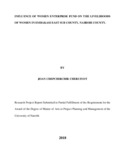| dc.contributor.author | Cheruiyot, Joan C | |
| dc.date.accessioned | 2019-01-23T07:07:43Z | |
| dc.date.available | 2019-01-23T07:07:43Z | |
| dc.date.issued | 2018 | |
| dc.identifier.uri | http://hdl.handle.net/11295/105307 | |
| dc.description.abstract | Poverty is a phenomenon that touches a lot of people all around the world. The populations that are affected the most are women. This occurs as a result of the various gender inequalities in sectors such as education, health care, informal situations such as employment and even in the political arena. Women do most of the unpaid work in the home such as cooking, cleaning, taking care of children and sick relatives leaving little time to engage in income generating activities. Their chances of getting out of poverty is also less as compared to men. Most households that are headed by women experience higher instances of poverty as they shoulder most of the responsibilities of the home. In this regard, the Kenyan government set up mechanisms to help women get out of poverty such as the Women Enterprise Fund (WEF), the Youth Enterprise Development Fund (YEDF), and the Uwezo fund. This study focused on the WEF strategies to provide affordable and accessible credit to women groups and how it has influenced the livelihoods of women who have benefited from it. The objective of this fund is to give women access to low interest loans that they can use to develop economically and become financially independent. This study therefore sets out to investigate the influence that these strategies by WEF have had on the livelihood of women. The study was conducted in Embakasi East constituency which is in Nairobi County. The objectives that guided this study were to a) Examine the influence of loans given by WEF on the livelihoods of women b) To establish the influence of training programs offered by WEF on the livelihoods of women c) To analyze the extent to which linkages with large enterprises by WEF influence the livelihoods of women .A descriptive survey design was adopted while purposive sampling was employed to select respondents from the population who were members of women groups. The target population were 167 women groups who have borrowed loans from WEF in Embakasi East constituency. A sample of 117 women groups were sampled, with the sample being derived using the Yamane sample size formula. The research instruments that were employed were structured and unstructured questionnaires and interviews. Data collected was analyzed and presented using the statistical package for social scientists (SPSS). Descriptive statistics were adopted as a means of analyzing and summarizing data. The study established that the products put in place by WEF were beneficial and brought about a change for the positive on the livelihoods of women. Loans provided by WEF had a positive influence on the livelihoods of women through being a vehicle for individual economic development. Trainings and capacity building provided the groups with skills and the necessary impetus to successfully manage group projects and repay loans on time. Market support and linkages provided the women an avenue for exposure and a marketing platform for their projects. The study recommends extending period of loan repayment particularly for higher loan amounts. Providing support and mentorship to groups to aid in growth and linking groups to other large enterprises for exposure. | en_US |
| dc.language.iso | en | en_US |
| dc.publisher | University of Nairobi | en_US |
| dc.rights | Attribution-NonCommercial-NoDerivs 3.0 United States | * |
| dc.rights.uri | http://creativecommons.org/licenses/by-nc-nd/3.0/us/ | * |
| dc.subject | Women In Embakasi East Sub County | en_US |
| dc.title | Influence Of Women Enterprise Fund On The Livelihoods Of Women In Embakasi East Sub County, Nairobi County. | en_US |
| dc.type | Thesis | en_US |



